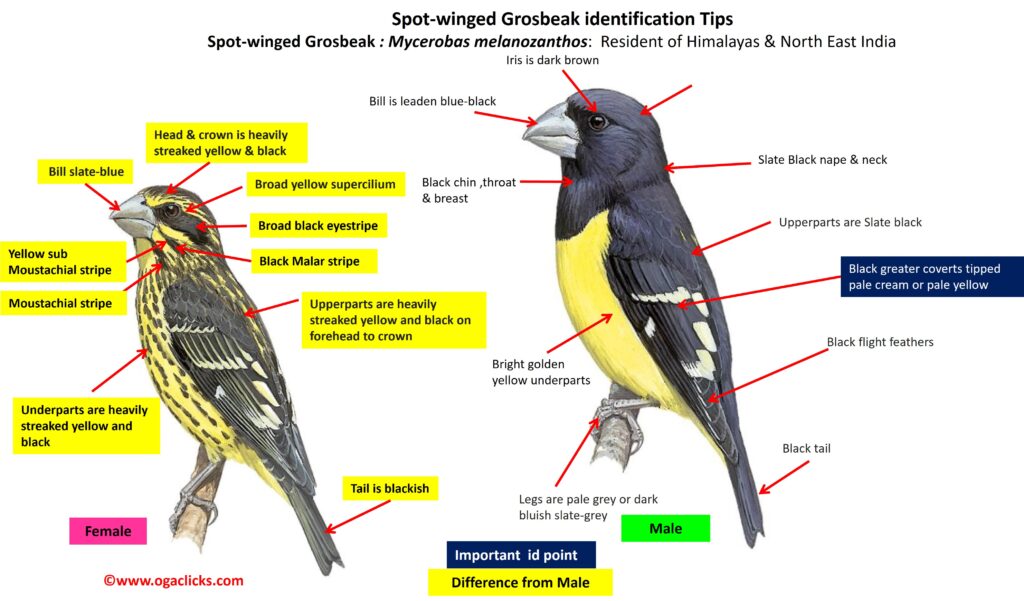Spot-winged Grosbeak

Spot-winged Grosbeak Mycerobas melanozanthos
Etymology:
- Mycerobas : Greek word moukerobas –nut-breaker
- Melanozanthos : Greek word melas – black; xanthos – Yellow
Vernacular Names: Kash: Wyet-tont, Lepcha: Maltam-pho
Distribution in India: Summer and winter visitor in Himalayan foothills. Resident of Central India and North east India
Description: Size of 16-18 cm Male has head to upper back and to lower breast sooty black or blackish-grey, scapulars black with dull yellow tips on rearmost feathers; lower back and rump dull yellow, upper tail-coverts black or blackish with dull yellow tips; tail and wing black, tips of inner greater coverts deep yellow; belly and flanks to under tail-coverts dull yellow; iris dark brown; bill dark grey or blackish-horn, paler base of lower mandible; legs pale brown to pinkish-brown. the female has head to lower back slate-grey, rump dull yellow or olive-yellow, upper tail-coverts dark grey, fringed dull yellow;
black or blackish-grey; wing as on male, but blackish-grey (not black), inner greater coverts tipped pale olive-yellow, flight-feathers finely edged olive-yellow, white patch at base of outer primaries smaller, tertials edged pale yellow or yellowish-buff and tipped paler greyish-white; face and underparts slightly paler grey, finely streaked whitish on cheek, ear-coverts and throat to center of breast; belly greyish-yellow, becoming yellowish-olive on under tail-coverts; bare parts much as for male. The juvenile and first-winter are like female, but duller or more mottled paler yellow or buffish, scapulars and lower back to uppertail-coverts are fringed olive, underparts are pale whitish-yellow and more heavily or continuously streaked black; first-summer male similar to juvenile, but throat and upper breast tinged variably warm buff, reddish or rufous-brown.
Habitat: It is found in Sub montane and montane juniper (Juniperus) and spruce (Picea) forest, mixed fir (Abies) and deciduous forest with rhododendron (Rhododendron), dwarf juniper and bamboo, also sparse bushes and scattered scrub on slopes at or above tree-line.
Food Habits: It eats mostly juniper berries (with pulp discarded), also berries of dogwood (Cornus), also seeds of spruce and mountain ash (Cerasus), rose hips (Rosa), docks (Rumex) and strawberries (Fragaria). Sometimes small insects are eaten during breeding. A noisy feeder; uses large bill to break open hard shells, and drops shell and pulp to ground. Usually in pairs or in small to medium-sized flocks, and in mixed flocks with other finches
Breeding Habits: They breed in May–Sept. Monogamous. Solitary. Nest built by female, a loose or bulky cup of fine twigs, plant stems and fibers, juniper bark strips and grass, on a platform of twigs, placed up to 2 m above ground and well concealed by surrounding foliage in spruce or juniper tree, sometimes other tree. Clutch of 2–3 eggs, incubation by both sexes, mainly by female, period 15–16 days; nestling period 17–18 days; young fed by parents for at least one week and possibly for up to two months after leaving nest.